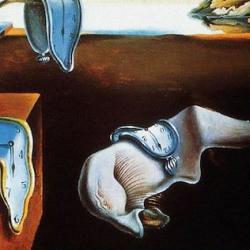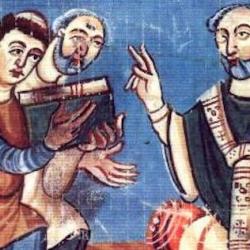“To date,” writes Norbert Elias in his Essay on Time, “enquiries into the sociology of time are almost non-existent” (38). This deficit, he suggests, is due to a dichotomy of the natural and human worlds, a dichotomy reflected in academic specializations (71).
He blames the “conventional tendency to explore ‘nature’ and ‘society’ and, therefore, the physical and sociological problems of ‘time’ as if they were completely independent of each other” (38). Natural and human sciences have different languages, methods, goals, “as if it were an eternal divide in the world itself” (72-3). In fact, this doesn’t match reality, and dichotomies like this “effectively block” enquires into time (73). Social scientists leave time to the physicists or risk venturing into metaphysics.
(The situation isn’t as dire today as when Elias wrote his essay. Perhaps it wasn’t all that dire in his own day. Barbara Adam has devoted several books to the sociology of time; see posts here, here, and here. Anthony Giddens has examined modernity’s time; see here.)
Elias proposes to overcome the dichotomy of natural and social time. He begins this effort by distinguishing time and timing. The noun “time” seduces us into thinking of time as an object, almost a mode of space. Elias is interested in timing, the coordination of actions and people. What we experience as time has to do with timing.
And timing is the human activity of sychronization, dependent on human action. Measurement of time requires three things: people, and at least two continua of change. Time is measured when one continua of change is used as a frame of reference for another continuum. Time is a “conceptual symbol of gradually advancing synthesis, a setting-up of fairly complex relationship between continua of changes of various kinds” (40).
Timing involves fixing positions in one sequence by reference to another sequence. The sequences can involve any level of human experience – physical, biological, social, personal, mechanical.
Though used by natural scientists, time measurement is an entirely social and human construction. Time in this sense has a coordinating and integrating function. It helps us weave our lives together, so that we intersect at the same places at the same time, so that social events can take place.
When we emphasize timing “the sharp conceptual distinction between ‘nature’ and ‘history'” becomes “untenable.” We come to realize that this dichotomy is itself “epoch-specific” (61).
These socially constructed periods of time become habitual and we come to see them as natural, as built into the cosmos: “One does not see clearly that a year has a social function and a social reality related to, but distant from, a natural reality; one is apt to perceive it simply as something established by nature” (46). The year comes about because people coordinate the continua of the earth’s revolution around the sun with a continua of events marked by a calendar.
Timing depends on an abstraction from different sequences of action. How can a sequence of events in the sky be used to mark events that take place on earth? How can watch, a continuous mechanical sequence, be used to measure another continuous sequence? What do they have in common?
He answers, “the very fact that they are continuously changing in a fairly regular sequential order.” This is the “concept of time”: “properties which sequences of continuous changes have in common, regardless of their differences in kind” (60). Time is thus “a frame of reference used by people of a particular group, and finally by humankind, to set up milestones recognized by the group within a continuous sequence of changes, or to compare one phase in such a sequence with phases in another, and in a variety of other ways” (60).
Along the way, Elias tackles the Augustinian paradox of the present. The present time is all that we have, and yet the present moment passes before we can grab it. It’s past as soon as we think “present.”
Elias thinks that this mistakes the relationship of the present to the past and future. Past, present, and future aren’t distinct entities but aspects of one complex concept (63). The concept of the present is impossible without concept of past. To speak of a “present” requires that a group can “distinguish as the present what they are doing here and now, what they are directly experiencing and feeling, both from what is over and subsists only in memory, and from what they may possibly do, experience or suffer, that is, from the past and the future” (64).
Past, present, and future, he argues, aren’t natural phenomenon. They exist in nature only “by virtue of an anthropomorphic identification – that is, figuratively, as when we speaks of the future of the sun.” Nature is “a continuous sequence of changes in the configurations of energy-matter.” Outside the experiential relationship to human beings, “the division of ‘natural’ continua of changes into past, present and future is meaningless” (66).
But it’s precisely here that Elias’s effort to overcome the dichotomy of natural and human sciences, natural and human time, breaks down. Events, he argues, “take on the character of the present in conjunction with the experience of a past and a future. In the flow of events there are no segments of this kind. What is past merges seamlessly with the present, as the present does with the future.” Only “in human experience” is the division of past, present, future sensible (67).
But what is this seamless flow of events? It appears to be the continuous time of the natural world, which persists in, with, and under the human measuring, ordering, and synchronizing of time. And that appears to be very close to the dichotomy Elias intended to abandon.
That the dichotomy remains in place is evident in his evolutionary account of the emergence of human time as a “fifth dimension of the universe.” The arrival of human beings means “universe takes on, in addition to the four dimensions of space and time, a fifth dimension of consciousness, experience, or however one may express it” (67).
Here is Elias’s story of time: Late-emerging humans “succeeded in replacing the comparatively irregular movements of sun, moon and other stars as a measure of dating, a means of synchronization, by an increasingly close and regular mesh of human-made timing devices; and then, as will be seen, they themselves became so attuned to the synchronization of their behaviour with clocks and calendars that they have come to experience their consciousness of time as a mysterious component of their own nature, or perhaps reified time as a gift of the gods” (69).
But that story depends on the late arrival of human beings, not to mention the absence of God. Suppose, hypothetically, that there was a God who created the world in a week, and created an original man and woman on the sixth day, and informed them of the process of creation. Suppose this God set aside the seventh day, and marked it as a sacred day for human beings as well.
If this happened, there would be no “flow of events” prior to segmentation into parts; the week came to the first human beings pre-segmented. No aeons of time preceded the human effort to take dominion of time by timing, by synchronizing sequence A and sequence B.
The dichotomy of natural and human time can be healed only when we recognize humans as part of nature, and confess also that nature exists to be humanized.











